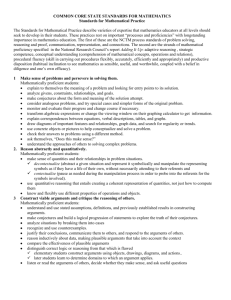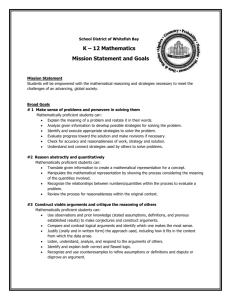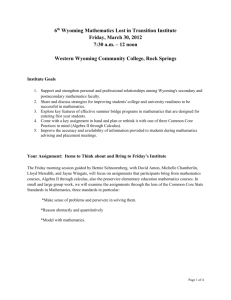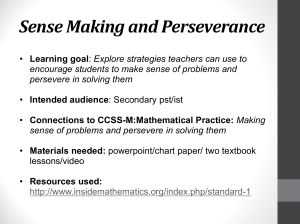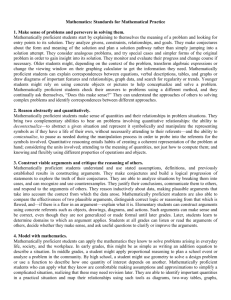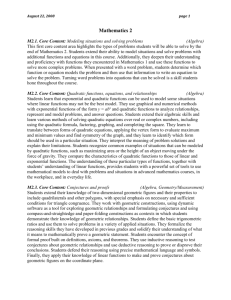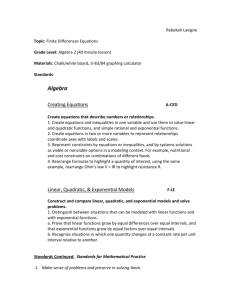I. Mathematics II - Dexter Consolidated Schools
advertisement
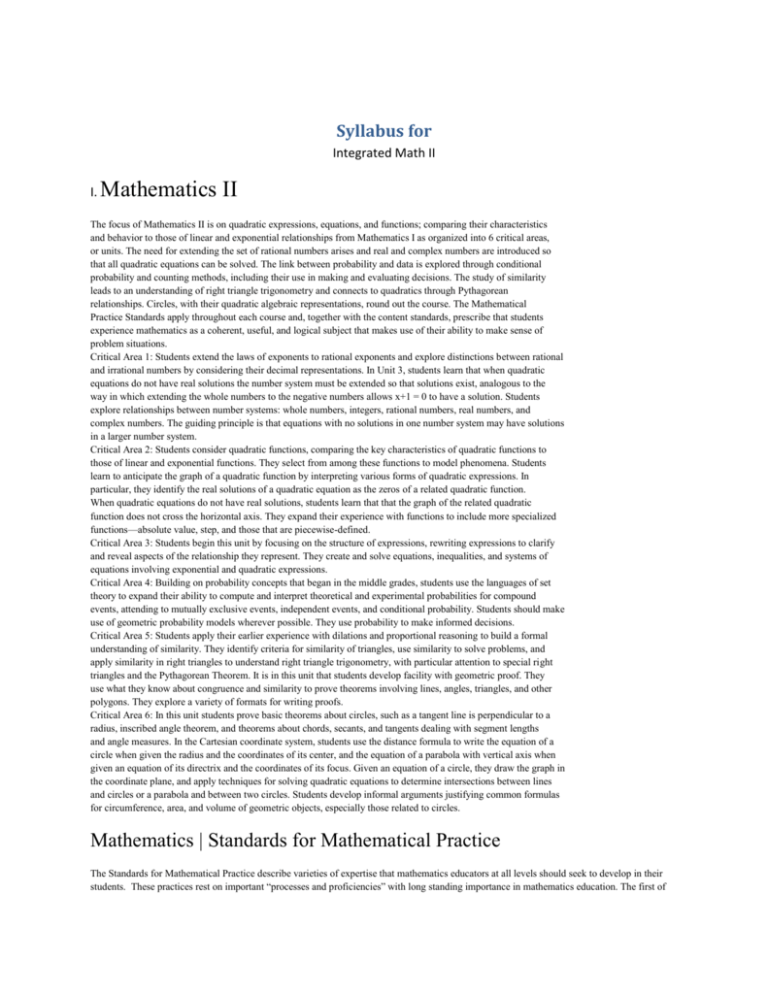
Syllabus for Integrated Math II I. Mathematics II The focus of Mathematics II is on quadratic expressions, equations, and functions; comparing their characteristics and behavior to those of linear and exponential relationships from Mathematics I as organized into 6 critical areas, or units. The need for extending the set of rational numbers arises and real and complex numbers are introduced so that all quadratic equations can be solved. The link between probability and data is explored through conditional probability and counting methods, including their use in making and evaluating decisions. The study of similarity leads to an understanding of right triangle trigonometry and connects to quadratics through Pythagorean relationships. Circles, with their quadratic algebraic representations, round out the course. The Mathematical Practice Standards apply throughout each course and, together with the content standards, prescribe that students experience mathematics as a coherent, useful, and logical subject that makes use of their ability to make sense of problem situations. Critical Area 1: Students extend the laws of exponents to rational exponents and explore distinctions between rational and irrational numbers by considering their decimal representations. In Unit 3, students learn that when quadratic equations do not have real solutions the number system must be extended so that solutions exist, analogous to the way in which extending the whole numbers to the negative numbers allows x+1 = 0 to have a solution. Students explore relationships between number systems: whole numbers, integers, rational numbers, real numbers, and complex numbers. The guiding principle is that equations with no solutions in one number system may have solutions in a larger number system. Critical Area 2: Students consider quadratic functions, comparing the key characteristics of quadratic functions to those of linear and exponential functions. They select from among these functions to model phenomena. Students learn to anticipate the graph of a quadratic function by interpreting various forms of quadratic expressions. In particular, they identify the real solutions of a quadratic equation as the zeros of a related quadratic function. When quadratic equations do not have real solutions, students learn that that the graph of the related quadratic function does not cross the horizontal axis. They expand their experience with functions to include more specialized functions—absolute value, step, and those that are piecewise-defined. Critical Area 3: Students begin this unit by focusing on the structure of expressions, rewriting expressions to clarify and reveal aspects of the relationship they represent. They create and solve equations, inequalities, and systems of equations involving exponential and quadratic expressions. Critical Area 4: Building on probability concepts that began in the middle grades, students use the languages of set theory to expand their ability to compute and interpret theoretical and experimental probabilities for compound events, attending to mutually exclusive events, independent events, and conditional probability. Students should make use of geometric probability models wherever possible. They use probability to make informed decisions. Critical Area 5: Students apply their earlier experience with dilations and proportional reasoning to build a formal understanding of similarity. They identify criteria for similarity of triangles, use similarity to solve problems, and apply similarity in right triangles to understand right triangle trigonometry, with particular attention to special right triangles and the Pythagorean Theorem. It is in this unit that students develop facility with geometric proof. They use what they know about congruence and similarity to prove theorems involving lines, angles, triangles, and other polygons. They explore a variety of formats for writing proofs. Critical Area 6: In this unit students prove basic theorems about circles, such as a tangent line is perpendicular to a radius, inscribed angle theorem, and theorems about chords, secants, and tangents dealing with segment lengths and angle measures. In the Cartesian coordinate system, students use the distance formula to write the equation of a circle when given the radius and the coordinates of its center, and the equation of a parabola with vertical axis when given an equation of its directrix and the coordinates of its focus. Given an equation of a circle, they draw the graph in the coordinate plane, and apply techniques for solving quadratic equations to determine intersections between lines and circles or a parabola and between two circles. Students develop informal arguments justifying common formulas for circumference, area, and volume of geometric objects, especially those related to circles. Mathematics | Standards for Mathematical Practice The Standards for Mathematical Practice describe varieties of expertise that mathematics educators at all levels should seek to develop in their students. These practices rest on important “processes and proficiencies” with long standing importance in mathematics education. The first of these are the NCTM process standards of problem solving, reasoning and proof, communication, representation, and connections. The second are the strands of mathematical proficiency specified in the National Research Council’s report Adding It Up: adaptive reasoning, strategic competence, conceptual understanding (comprehension of mathematical concepts, operations and relations), procedural fluency (skill in carrying out procedures flexibly, accurately, efficiently and appropriately), and productive disposition (habitual inclination to see mathematics as sensible, useful, and worthwhile, coupled with a belief in diligence and one’s own efficacy). 1 Make sense of problems and persevere in solving them. Mathematically proficient students start by explaining to themselves the meaning of a problem and looking for entry points to its solution. They analyze givens, constraints, relationships, and goals. They make conjectures about the form and meaning of the solution and plan a solution pathway rather than simply jumping into a solution attempt. They consider analogous problems, and try special cases and simpler forms of the original problem in order to gain insight into its solution. They monitor and evaluate their progress and change course if necessary. Older students might, depending on the context of the problem, transform algebraic expressions or change the viewing window on their graphing calculator to get the information they need. Mathematically proficient students can explain correspondences between equations, verbal descriptions, tables, and graphs or draw diagrams of important features and relationships, graph data, and search for regularity or trends. Younger students might rely on using concrete objects or pictures to help conceptualize and solve a problem. Mathematically proficient students check their answers to problems using a different method, and they continually ask themselves, “Does this make sense?” They can understand the approaches of others to solving complex problems and identify correspondences between different approaches. 2 Reason abstractly and quantitatively. Mathematically proficient students make sense of quantities and their relationships in problem situations. They bring two complementary abilities to bear on problems involving quantitative relationships: the ability to decontextualize—to abstract a given situation and represent it symbolically and manipulate the representing symbols as if they have a life of their own, without necessarily attending to their referents—and the ability to contextualize, to pause as needed during the manipulation process in order to probe into the referents for the symbols involved. Quantitative reasoning entails habits of creating a coherent representation of the problem at hand; considering the units involved; attending to the meaning of quantities, not just how to compute them; and knowing and flexibly using different properties of operations and objects. 3 Construct viable arguments and critique the reasoning of others. Mathematically proficient students understand and use stated assumptions, definitions, and previously established results in constructing arguments. They make conjectures and build a logical progression of statements to explore the truth of their conjectures. They are able to analyze situations by breaking them into cases, and can recognize and use counterexamples. They justify their conclusions, Common Core State Standards for MAT HEMAT ICS standards for mathematical practice | 7 communicate them to others, and respond to the arguments of others. They reason inductively about data, making plausible arguments that take into account the context from which the data arose. Mathematically proficient students are also able to compare the effectiveness of two plausible arguments, distinguish correct logic or reasoning from that which is flawed, and—if there is a flaw in an argument—explain what it is. Elementary students can construct arguments using concrete referents such as objects, drawings, diagrams, and actions. Such arguments can make sense and be correct, even though they are not generalized or made formal until later grades. Later, students learn to determine domains to which an argument applies. Students at all grades can listen or read the arguments of others, decide whether they make sense, and ask useful questions to clarify or improve the arguments. 4 Model with mathematics. Mathematically proficient students can apply the mathematics they know to solve problems arising in everyday life, society, and the workplace. In early grades, this might be as simple as writing an addition equation to describe a situation. In middle grades, a student might apply proportional reasoning to plan a school event or analyze a problem in the community. By high school, a student might use geometry to solve a design problem or use a function to describe how one quantity of interest depends on another. Mathematically proficient students who can apply what they know are comfortable making assumptions and approximations to simplify a complicated situation, realizing that these may need revision later. They are able to identify important quantities in a practical situation and map their relationships using such tools as diagrams, twoway tables, graphs, flowcharts and formulas. They can analyze those relationships mathematically to draw conclusions. They routinely interpret their mathematical results in the context of the situation and reflect on whether the results make sense, possibly improving the model if it has not served its purpose. 5 Use appropriate tools strategically. Mathematically proficient students consider the available tools when solving a mathematical problem. These tools might include pencil and paper, concrete models, a ruler, a protractor, a calculator, a spreadsheet, a computer algebra system, a statistical package, or dynamic geometry software. Proficient students are sufficiently familiar with tools appropriate for their grade or course to make sound decisions about when each of these tools might be helpful, recognizing both the insight to be gained and their limitations. For example, mathematically proficient high school students analyze graphs of functions and solutions generated using a graphing calculator. They detect possible errors by strategically using estimation and other mathematical knowledge. When making mathematical models, they know that technology can enable them to visualize the results of varying assumptions, explore consequences, and compare predictions with data. Mathematically proficient students at various grade levels are able to identify relevant external mathematical resources, such as digital content located on a website, and use them to pose or solve problems. They are able to use technological tools to explore and deepen their understanding of concepts. 6 Attend to precision. Mathematically proficient students try to communicate precisely to others. They try to use clear definitions in discussion with others and in their own reasoning. They state the meaning of the symbols they choose, including using the equal sign consistently and appropriately. They are careful about specifying units of measure, and labeling axes to clarify the correspondence with quantities in a problem. They calculate accurately and efficiently, express numerical answers with a degree of precision appropriate for the problem context. In the elementary grades, students give carefully formulated explanations to each other. By the time they reach high school they have learned to examine claims and make explicit use of definitions. Common Core State Standards for MAT HEMAT ICS standards for mathematical practice | 8 7 Look for and make use of structure. Mathematically proficient students look closely to discern a pattern or structure. Young students, for example, might notice that three and seven more is the same amount as seven and three more, or they may sort a collection of shapes according to how many sides the shapes have. Later, students will see 7 × 8 equals the well remembered 7 × 5 + 7 × 3, in preparation for learning about the distributive property. In the expression x2 + 9x + 14, older students can see the 14 as 2 × 7 and the 9 as 2 + 7. They recognize the significance of an existing line in a geometric figure and can use the strategy of drawing an auxiliary line for solving problems. They also can step back for an overview and shift perspective. They can see complicated things, such as some algebraic expressions, as single objects or as being composed of several objects. For example, they can see 5 – 3(x – y)2 as 5 minus a positive number times a square and use that to realize that its value cannot be more than 5 for any real numbers x and y. 8 Look for and express regularity in repeated reasoning. Mathematically proficient students notice if calculations are repeated, and look both for general methods and for shortcuts. Upper elementary students might notice when dividing 25 by 11 that they are repeating the same calculations over and over again, and conclude they have a repeating decimal. By paying attention to the calculation of slope as they repeatedly check whether points are on the line through (1, 2) with slope 3, middle school students might abstract the equation (y – 2)/(x – 1) = 3. Noticing the regularity in the way terms cancel when expanding (x – 1)(x + 1), (x – 1)(x2 + x + 1), and (x – 1)(x3 + x2 + x + 1) might lead them to the general formula for the sum of a geometric series. As they work to solve a problem, mathematically proficient students maintain oversight of the process, while attending to the details. II. Grading Scale(See DHS Handbook) Homework/Notebook –Preparation for summative assessment Formative Assessments-Preparation for summative assessment Summative Assessments/projects III. Required Resources – Student-provided a. Three –ring notebook 1 ½ inch or 2” b. 8 dividers c. Several pencils(enough to last all year) d. Notebook Paper 2-3 reams e. Red pen f. Graphing paper g. 2 bottles of hand-sanitizer h. 2 boxes of tissues i. 6-12 dry erase markers j. A calculator Texas Instruments TI-30X IIS(please buy only this type as well be teaching how to use this calculator properly and others are different in the way they work). Notebook set-up 5 dividers 1. Bell - include date Objective Bell work for that date 2. Notes - Include date 3. Formative assessment- include date 4. Vocabulary- include date 5. Homework- include date IV. Required Resources – School provided a. Textbook(Classroom set- Not issued to student) b. Agenda V. Policies and Procedures a. Attendance (See DHS Handbook) b. Tardy (See DHS Handbook) c. Make-up Work (See DHS Handbook) d. Extra- Credit-(See DHS Handbook) e. ICU ( Intensive Care Unit)(See DHS Handbook) VI. Plagiarism - Cheating in ay form, including plagiarism, is not tolerated. Any student caught cheating will receive a zero for that exam and/or risk receiving an F for the course. Plagiarism is defined as the use without proper acknowledgement of the ideas, phrases, sentences, or larger units o discourse taken from the work of another writer or speaker. In standard academic practice, this means if you copy any more than three consecutive words written or spoken by another, you must acknowledge the source of these words by using the proper reference notation. VII. VIII. IX. Students are responsible for all expectations indicated on the attached P.R. I.D.E matrix. Teachers provide leadership through modeling and teaching the P.R. I.D.E. matrix. Teacher school contact information (575-734-5420 ext 712)
